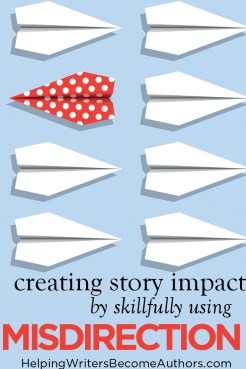[Just a short post today, so I can put some energy into a super-secret project I can’t wait to share with you all. Hint? It has to do with two of my favorite things: dreamzoning and archetypal character arcs. Stay tuned! I hope to do the big reveal no later than October.]
At first glance, the idea of misleading readers might seem like a bad idea. After all, stories that don’t give readers what they want usually end up tossed into the give-to-Goodwill pile. Readers hate being conned by authors—and yet learning how to use misdirection in your story can make readers you.
If that sounds contradictory, try thinking of it as being a little like a magic trick. A good magician knows how to artfully misdirect his audience’s attention in a way that leaves them delighted when a white dove unexpectedly bursts from a handkerchief. Why would an author want to attempt this trickery? Mostly for the same reason the magician does: because, as much as audiences hate to be conned, they love to be surprised.

My Cousin Rachel by Daphne du Maurier (affiliate link)
For example, in Daphne du Maurier’s famous suspense novel My Cousin Rachel, she leads readers to believe the narrator’s cousin (whom he’s never met) is an ugly harridan who will make the narrator’s life miserable when she comes to visit.
The first quarter of the book is filled with the protagonist’s misgivings about his cousin and downright belligerence toward her arrival. He makes up his mind to go out of his way to be rude to her, so she’ll make her visit as short as possible.
When she finally arrives, both he and the reader are surprised to find their expectations were completely off base. The cousin is lovely and charming, and narrator and readers alike fall promptly in love with her.
Du Maurier got away with her little deception for a couple of reasons:
1. She never lied to the reader.
Filtering her story through the narrator’s ignorant POV allowed her to honestly withhold from readers the truth about the cousin.
2. The narrator’s false impressions and their sudden reversal create an integral framework for the story.
As a result, readers are delighted to have witnessed the sleight of hand that misdirected their expectations and gave them a thrill of realization when the dove finally bursts from du Maurier’s handkerchief.
>>Click here to read Misdirection: Why We Have to Fool Our Readers
>>Click here to read Foreshadowing and Misdirection: Use Them Together to Empower Your Fiction
>>Click here to read Deepen Your Story With Character Misdirection
Wordplayers, tell me your opinions! How have you used misdirection in your story? Tell me in the comments!
The post originally appeared on following source : Source link

